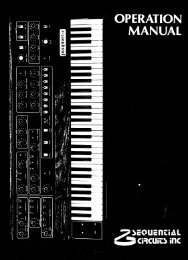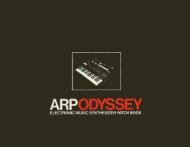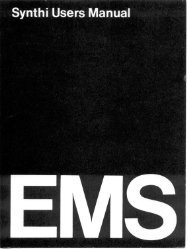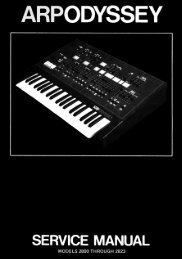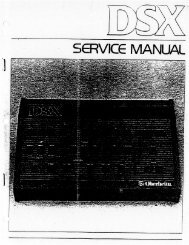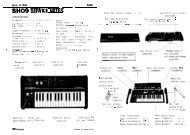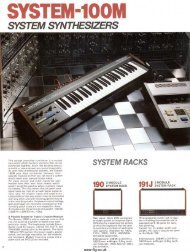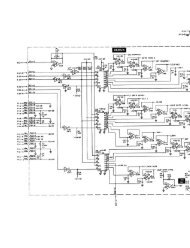ARP2600 - Fundamentals of Music Technology - Cyborgstudio.com
ARP2600 - Fundamentals of Music Technology - Cyborgstudio.com
ARP2600 - Fundamentals of Music Technology - Cyborgstudio.com
Create successful ePaper yourself
Turn your PDF publications into a flip-book with our unique Google optimized e-Paper software.
ABOUT THE FORMAT OF THIS BOOKThis book has many facets and serves many purposes to many people. While it is primarily gearedtowards an academic setting where the basic concepts <strong>of</strong> subtractive synthesis may be introduced, itcan also be <strong>of</strong> value in other ways, which are best left to be discovered by the reader.This book does not start from ground zero. It assumes that the reader has a small amount <strong>of</strong> knowledgein the area <strong>of</strong> basic acoustics. It is important to understand how sound travels, the concept <strong>of</strong> harmonics,frequency and how it is measured, basic waveforms and their harmonic content. It is <strong>com</strong>monpractice to begin a book such as this with a short chapter on acoustics, but since there are so manyexcellent books which cover these topics on a very accessible level, these topics have been omittedfrom this book. For persons interested in reading these books (it never hurts) a short list can be found inAppendix One.The book itself is grouped into five units. These units are then split into parts called sections. I felt thatthis was a more appropriate term than chapter since modular synthesizers are sectional devices bynature. Each section has several subheadings and illustrations. Following each section <strong>of</strong> text is a set <strong>of</strong>experiments that should be performed on the instrument. There is no substitute for hands-on experience.Following the experiments are a set <strong>of</strong> review questions and a list <strong>of</strong> all <strong>of</strong> the important termswhich were introduced in that section. These will primarily be <strong>of</strong> interest to persons in an academicsetting, but can also serve as a memory refresher for the casual reader.The rear <strong>of</strong> the book features a glossary <strong>of</strong> terms, including some background terms which are notincluded in the text itself. An index is also present for easy reference <strong>of</strong> terms and concepts.This book includes an audio CD which contains sounds played on an ARP 2600. This disc serves threepurposes. First, it allows people to check the results <strong>of</strong> their experiments to see if they have <strong>com</strong>e upwith the correct sound. Secondly, it allows people who do not have access to a 2600 to hear the results<strong>of</strong> each audio experiment and some examples in the text. It will also allow them to hear what thismarvelous instrument can do. Finally, it can be used as a source <strong>of</strong> analog synthesizer samples for asampler. (Please read the sample use agreement on page ii if you intend to use the CD for this purpose.The license granted to you is fairly unrestrictive, but there are certain legal obligations which must bemet if the disc is to be used for this purpose.)One final note about this book is that in many <strong>of</strong> the examples, the subject in the experiment is referredto as ‘Bob’ or ‘Wendy.’ This is in honor <strong>of</strong> Dr. Robert Moog and Wendy Carlos. Dr. Moog invented thefirst <strong>com</strong>mercially available synthesizer and invented many <strong>of</strong> the modules described in this book.Wendy Carlos is an excellent musician/<strong>com</strong>poser/inventor whose wonderful recording “Switched-OnBach,” performed on Bob Moog’s Series IIIp synthesizer, still holds the record as the best sellingclassical album <strong>of</strong> all time.xiv




